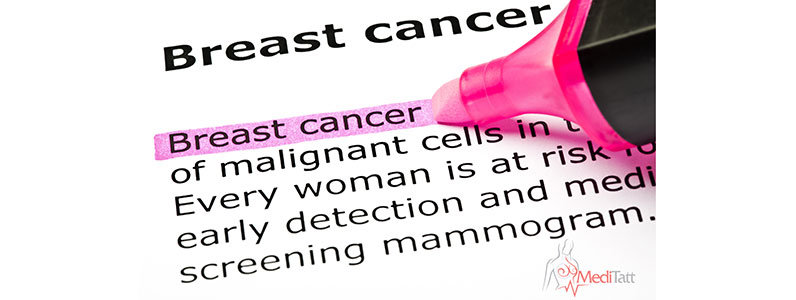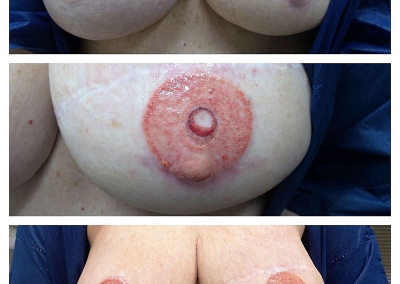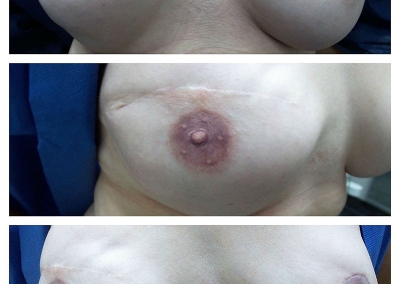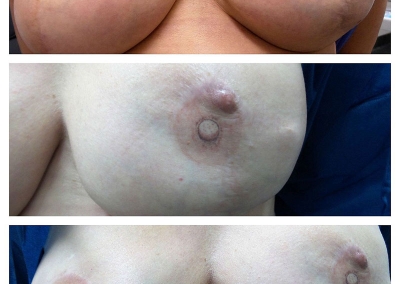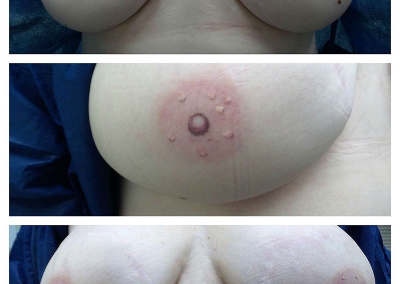
For many breast cancer survivors nipple tattooing may be the final step in their breast reconstruction journey. This often involves creating the illusion of protrusion through the skillful design and application of colour performed by an experienced medical cosmetic tattooist.
BREAST CANCER FACTS
Sadly one in eight women will develop breast cancer in their lifetime and on average 47 women, every day is diagnosed with breast cancer in Australia.
Did you know that age is one of the risk factors for developing breast cancer, and more than two in three cases of breast cancer occur in women aged between 40 and 69 years?
Early detection is the key, and it is attributed to improved survival rates through regular screening combined with improved treatment outcomes. All that said we still have on average seven women in Australia that die from breast cancer every day.
FEELING COMPLETE
Nipple areola tattooing is the final step in the breast reconstruction process, and for many women, it will be the very last procedure they undergo to complete their whole breast cancer and reconstructive journey. Some patients feel they have been through enough and just don’t want to have further surgery and choose not to proceed to have a reconstructed nipple. While other women want to have everything returned to the way they were before breast cancer, this includes nipple reconstruction and re-colouration of the nipple areola complex.
There are several options when it comes to re-colouration of the areola complex. Some women choose the non-surgical option of cosmetic tattooing and proceed without nipple reconstruction and speaking from a medical tattooist’s point of view this provides me with the opportunity to use my skills to simulate or recreate protrusion of the nipple areola without the contour of an actual nipple. While other patients undergo nipple reconstruction and the medical tattooist simply completes the reconstruction by adding a final touch of colour, providing realism and texture.
BODY TATTOO OR COSMETIC MEDICAL TATTOOING
Areola tattooing is specialised work which means most industry professionals should work on referral from the plastic and reconstructive surgeons and hospitals and maintain high clinical procedural standards, continued education and training, embrace advancing techniques and possess a natural ability to show empathy and compassion to provide the best outcomes for all patients.
What’s in the bottle? There are serious concerns over body artists providing areola tattooing to breast cancer survivors, and these concerns come from the tattoo inks being used. Body tattoo inks have been found to contain carcinogenic compounds in the form of azo dyes with the bonus of bacteria. Now we all know body tattoos are in popular demand as a fashion item and body tattooists can be very artistic however serious considerations should be made as to why medical tattooing should only be provided by well-trained cosmetic medical tattooist.
In 2014 there was a recall of body tattoo inks across the world, and regular testing of body tattoo inks continues to unearth bacteria in the bottles. Until the testing proves otherwise, I don’t agree with implanting body art pigments into a person that has undergone mastectomies, adjuvant therapies and reconstructions especially when these women have already had a battle with cancer and their immune system is often compromised.
TESTING
Pick your practitioner carefully as only certain cosmetic tattoo pigments undergo rigorous testing. Resolution ResAP (2008) on requirements and criteria for the safety of tattoos and permanent makeup provides a requirement for testing of cosmetic tattoo pigments it includes a list of negative substances that should not be present in cosmetic tattoo pigments, these include colourants and aromatic amines, as well as the maximum concentrations for some impurities. The recommendation also provides the criterion for the safety assessment of the used chemicals and encourages establishing a positive list of substances proved to be safe for their use under certain conditions.
PRACTITIONER
As you can see, there are a few things that must be considered before you undergo any cosmetic procedure. Medical tattooists must have artistic and technical competence with a good understanding of the appearance, variations and structure of the areola. It’s important that the technician has an adequate understanding of the different types of reconstructive surgeries that they may encounter as well as sound knowledge of the reconstruction process affording the patient a high level of satisfaction with the outcome of their nipple-areola complex tattoo.
Nipple-areola complex re-colouration is usually reserved as the final step in the breast reconstruction process and is critical for providing an aesthetically pleasing breast. Patients with loss of the nipple and areola continue to experience psychological distress even long after breast reconstruction has taken place. Following mastectomy and breast reconstruction, nipple-areola complex re-colouration can provide significant psychological benefits to the client.
BODY IMAGE
Completion of the breast reconstruction by performing a re-coloration procedure that gives the appearance of a realistic nipple-areola complex concerning symmetry, size, shape, colour and position adds significantly to the reconstructive result and satisfactory outcomes for all involved. However, most importantly, re-coloration of the nipple-areola complex has a high impact on overall patient satisfaction and acceptance of body image post procedure.
Tattooing areolas really isn’t just about someone knowing how to tattoo. It should be more about them understanding the reconstructive process, wound healing, immunity, and other factors that affect breast cancer patients. Working with breast cancer patients as a Medical Cosmetic tattooist can be challenging but also rewarding and over the past seven years and I’ve come to understand from experience that each patient presents with their own physical and psychological story.
Assisting the surgeons in completing the breast reconstruction process through the skillful application of colour in the form of nipple areola tattooing definitely provides most breast cancer patients with much-needed emotional and physical healing. For many, it represents the end to a very stressful chapter in their lives but not to forget it’s not always the end of the journey for all patients as metastatic breast cancer (MBC) affects some of our patients. Throughout this article, we will touch on the psychological aspects of breast reconstruction including some of the surgical processes involved in mastectomy and breast reconstruction.
In recent times it has been a struggle with social media and community standards as to what is acceptable, as far as images of our work. Male breast images are acceptable however female breast images are not allowed and breach these standards. We know that the female breast has always been regarded as a symbol of femininity and our breasts are extremely important in our lives often forming an integral part of our physical and indirectly psychological sense of wholeness. Differences from “normal” size or shape are often perceived as unattractive. So, this is by no means just an aesthetic problem as these differences often have adverse long term effects on body image, emotional well-being and can significantly reduce a woman’s self-esteem and quality of life.
Thankfully, our plastic surgeons have always been aware of this problem and have attempted to develop appropriate surgical measures to address it. Along with advances in surgical techniques, silicone breast implants have contributed significantly to improvements and all surgical measures have the common goal of improving the appearance of the breast to conform to what the patient finds aesthetically pleasing, and of course, the patients’ perception of her-self is of vital significance. Changes may involve reducing the size, altering the shape without reducing substance, enlargement or establishing symmetry. In reality, it is not always possible to satisfy every patient through surgical techniques and this is where the medical cosmetic tattooist can work closely with a surgeon and through the skillful application of colour can assist the surgeon to satisfy an individual patient’s requirements to achieve a positive outcome.
The indications for each surgical treatment are based on different assessment criteria. Often for the patient, breast asymmetry can be a significant cosmetic problem and may result in psychological distress. Treatment may be provided due to either aesthetic or psychological reasons. One example would be a patient may suffer from physical complaints due to abnormally large breasts that particularly cause pain in the breast and back. The indications for breast surgery are based on various assessment criteria, and it should be mentioned that aesthetic breast surgery is not the same as “cosmetic surgery, “even though breast enlargement with silicone implants is regarded a form of cosmetic surgery.
In the treatment of breast cancer, increasing attention is being given to psychological and aesthetic factors, provided they do not compromise oncological safety. Such factors were ultimately responsible for the development of breast conserving surgery. Two-thirds of breast cancer patients now benefit from the use of breast-contouring techniques. However, approximately one- third of patients have to undergo (modified radical) mastectomy so reconstruction should form part of the treatment plan from the beginning.
Modified radical mastectomy is defined as a total mastectomy, which is complete removal of the mammary gland, including the nipple-areola complex. The skin envelope, including the pectoralis fascia, is preserved for primary wound closure. The advantages of implant reconstruction are the short amount of time required to complete the reconstruction and the avoidance of additional scarring or a donor-site defect. Implant placement differs considerably between immediate and delayed reconstruction. In primary implant placement, complete muscle coverage should be obtained, since the post mastectomy skin flaps are unable to provide stable coverage for the implant. However, in recent times with the advent of Acellular Dermal Matrix, plastic surgeons have the option to consider using ADM where patients don’t require LD or DIEP flap coverage. ADM is a specialised surgical mesh or prosthetic mesh that is used to create a sling within the chest that cradles the implant and is created from using biological, alloplastic human or animal.
The good news is that women who have had implant-based breast reconstruction report that they no longer feel deformed as they did following mastectomy and that they feel more normal and less depressed about their appearance. They also report that breast reconstruction with breast implants aided their recovery from breast cancer and reduced emotional stress by helping to restore the body to a more natural appearance. Remembering, that woman who undergo breast reconstruction often don’t retain their own nipples or areolas. In this instance a medical cosmetic tattooist can recreate a natural looking nipple and areola complex and from personal experience I know this final step often benefits not only the patient’s physical appearance but also aids in their emotional recovery.
References
http://www.breastreconstruction.org/SecondaryProcedures/NippleAreolaReconstruction.html
http://www.ncbi.nlm.nih.gov/pmc/articles/PMC4115772/
http://www.breastcancer.org/treatment/surgery/reconstruction/types/implants/what-to-expect
http://www.mayoclinic.org/tests-procedures/breast-reconstruction/basics/what-you-can-expect/prc-20020485
http://www.ncbi.nlm.nih.gov/pmc/articles/PMC4115772/
Journal:
EMedicine-Medscape.com Breast Reconstruction, Nipple Areola Reconstruction
Yoon Sun Chun, MD, Clinical Instructor, Department of Surgery, Harvard Medical School; Associate Surgeon, Department of Surgery, Division of Plastic and Reconstructive Surgery, Brigham and Women’s Hospital; Staff Surgeon, Department of Surgery, Division of Plastic and Reconstructive Surgery, Faulkner Hospital
Dennis P Orgill, MD, PhD, Professor of Surgery, Harvard Medical School; Associate Chief of Plastic Surgery, Brigham and Women’s Hospital
Breast Reconstruction after Mastectomy 2014 Copyright American Cancer Society
Book:
Gabka, C J Bohmert, H & Blondeel, P N (2009) Plastic and reconstructive surgery of the breast Stuttgart: Thieme


